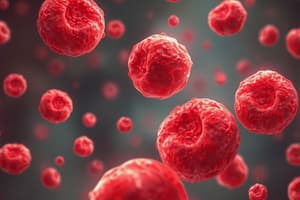Podcast
Questions and Answers
Which dietary source is most commonly associated with vitamin B12?
Which dietary source is most commonly associated with vitamin B12?
- Eggs and dairy products (correct)
- Citrus fruits
- Leafy green vegetables
- Whole grains
What is the primary transport mechanism for iron in the body?
What is the primary transport mechanism for iron in the body?
- Albumin
- Hemoglobin
- Transferrin (correct)
- Ferritin
Which of the following clinical findings is most indicative of folic acid deficiency?
Which of the following clinical findings is most indicative of folic acid deficiency?
- Glossitis and macrocytic anemia (correct)
- Pale skin and fatigue
- Jaundice and dark urine
- Neuropathy and balance issues
Which statement correctly describes the storage of iron in the body?
Which statement correctly describes the storage of iron in the body?
In what manner does the body normally regulate iron levels?
In what manner does the body normally regulate iron levels?
Which dietary source is least likely to provide a significant amount of iron?
Which dietary source is least likely to provide a significant amount of iron?
What process primarily affects the absorption of vitamin B12 in the gastrointestinal tract?
What process primarily affects the absorption of vitamin B12 in the gastrointestinal tract?
Which mechanism is primarily involved in transporting iron throughout the bloodstream?
Which mechanism is primarily involved in transporting iron throughout the bloodstream?
Which clinical finding is most commonly associated with a deficiency in folic acid?
Which clinical finding is most commonly associated with a deficiency in folic acid?
What is the primary form of stored iron in the body?
What is the primary form of stored iron in the body?
Flashcards are hidden until you start studying
Study Notes
Nutritional Anemias Overview
- Nutritional anemias are a type of anemia caused by deficiencies in essential nutrients like iron, vitamin B12, and folic acid.
- Understanding these nutrients involves exploring their dietary sources, absorption mechanisms, body storage, transport systems, deficiency consequences, and clinical manifestations.
Iron
- Dietary Sources:
- Rich sources include red meat, poultry, fish, lentils, beans, tofu, cooked spinach, and fortified cereals.
- Absorption:
- Primarily occurs in the duodenum, influenced by heme vs. non-heme iron; heme iron is more efficiently absorbed.
- Body Stores:
- Stored mainly in the liver, spleen, and bone marrow in the form of ferritin and hemosiderin.
- Transport Mechanisms:
- Transferrin transports iron in the bloodstream; deficiency leads to lower transferrin saturation and higher total iron-binding capacity (TIBC).
- Clinical and Laboratory Findings:
- Symptoms include fatigue, pallor, and shortness of breath; laboratory tests reveal low hemoglobin, low serum ferritin, and high TIBC.
- Regulation Mechanism:
- Hepcidin is a key hormone that regulates iron absorption and distribution; high levels inhibit iron release from stores.
Vitamin B12
- Dietary Sources:
- Primarily found in animal products like meat, dairy, eggs; fortified cereals are important for vegans.
- Absorption:
- Absorption occurs in the ileum and requires intrinsic factor (produced in the stomach) for effective uptake.
- Body Stores:
- Can be stored in the liver for several years, making deficiency slower to develop.
- Transport Mechanisms:
- Transported by transcobalamin in the bloodstream; deficiency can lead to neurological symptoms and macrocytic anemia.
- Clinical and Laboratory Findings:
- Symptoms include fatigue, weakness, and neurological issues; laboratory findings show macrocytic red blood cells and low serum B12 levels.
Folic Acid
- Dietary Sources:
- Found in leafy green vegetables, tomatoes, citrus fruits, legumes, and fortified grains.
- Absorption:
- Absorbed in the proximal part of the small intestine; requires no intrinsic factor.
- Body Stores:
- Limited storage in the liver of around 5-10 mg; deficiency can develop within weeks.
- Transport Mechanisms:
- Transported in the blood mostly in its mono-glutamated form; deficiency primarily affects rapidly dividing cells.
- Clinical and Laboratory Findings:
- Symptoms include anemia and glossitis; laboratory tests reveal macrocytic anemia and low serum folate levels.
Summary
- An understanding of iron, vitamin B12, and folic acid is essential for diagnosing and treating nutritional anemias, highlighting the importance of dietary intake, absorption processes, body storage capabilities, and clinical indicators of deficiencies.
Nutritional Anemias Overview
- Nutritional anemias are a type of anemia caused by deficiencies in essential nutrients like iron, vitamin B12, and folic acid.
- Understanding these nutrients involves exploring their dietary sources, absorption mechanisms, body storage, transport systems, deficiency consequences, and clinical manifestations.
Iron
- Dietary Sources:
- Rich sources include red meat, poultry, fish, lentils, beans, tofu, cooked spinach, and fortified cereals.
- Absorption:
- Primarily occurs in the duodenum, influenced by heme vs. non-heme iron; heme iron is more efficiently absorbed.
- Body Stores:
- Stored mainly in the liver, spleen, and bone marrow in the form of ferritin and hemosiderin.
- Transport Mechanisms:
- Transferrin transports iron in the bloodstream; deficiency leads to lower transferrin saturation and higher total iron-binding capacity (TIBC).
- Clinical and Laboratory Findings:
- Symptoms include fatigue, pallor, and shortness of breath; laboratory tests reveal low hemoglobin, low serum ferritin, and high TIBC.
- Regulation Mechanism:
- Hepcidin is a key hormone that regulates iron absorption and distribution; high levels inhibit iron release from stores.
Vitamin B12
- Dietary Sources:
- Primarily found in animal products like meat, dairy, eggs; fortified cereals are important for vegans.
- Absorption:
- Absorption occurs in the ileum and requires intrinsic factor (produced in the stomach) for effective uptake.
- Body Stores:
- Can be stored in the liver for several years, making deficiency slower to develop.
- Transport Mechanisms:
- Transported by transcobalamin in the bloodstream; deficiency can lead to neurological symptoms and macrocytic anemia.
- Clinical and Laboratory Findings:
- Symptoms include fatigue, weakness, and neurological issues; laboratory findings show macrocytic red blood cells and low serum B12 levels.
Folic Acid
- Dietary Sources:
- Found in leafy green vegetables, tomatoes, citrus fruits, legumes, and fortified grains.
- Absorption:
- Absorbed in the proximal part of the small intestine; requires no intrinsic factor.
- Body Stores:
- Limited storage in the liver of around 5-10 mg; deficiency can develop within weeks.
- Transport Mechanisms:
- Transported in the blood mostly in its mono-glutamated form; deficiency primarily affects rapidly dividing cells.
- Clinical and Laboratory Findings:
- Symptoms include anemia and glossitis; laboratory tests reveal macrocytic anemia and low serum folate levels.
Summary
- An understanding of iron, vitamin B12, and folic acid is essential for diagnosing and treating nutritional anemias, highlighting the importance of dietary intake, absorption processes, body storage capabilities, and clinical indicators of deficiencies.
Studying That Suits You
Use AI to generate personalized quizzes and flashcards to suit your learning preferences.




